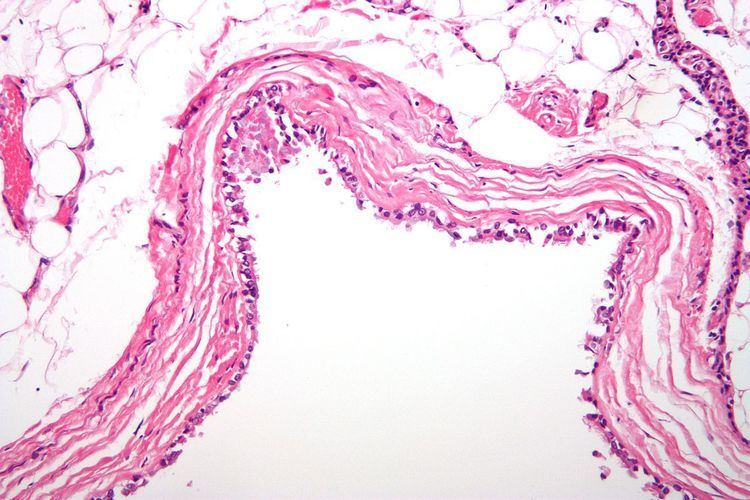MedlinePlus 003240 | MeSH D003560 | |
 | ||
Specialty | ||
A cyst is a closed sac, having a distinct membrane and division compared to the nearby tissue. Hence, it is a cluster of cells that have grouped together to form a sac (not unlike the manner in which water molecules group together, forming a bubble); however, the distinguishing aspect of a cyst is that the cells forming the "shell" of such a sac are distinctly abnormal (in both appearance and behaviour) when compared to all surrounding cells for that given location. It may contain air, fluids, or semi-solid material. A collection of pus is called an abscess, not a cyst. Once formed, a cyst may sometimes resolve on its own. When a cyst fails to resolve it may need to be removed by surgery but this will depend on what type of cyst it is and where in the body it has formed. Cancer-related cysts are formed as a defense mechanism for the body, following the development of mutations that lead to an uncontrolled cellular division. Once that mutation has occurred, the affected cells divide incessantly (and become known as cancerous), forming a tumour. The body encapsulates those cells to try and prevent them from continuing their division and try and contain the tumour, which becomes known as a cyst. That said, the cancerous cells can still mutate further and gain the ability to form their own blood vessels, from which they received nourishment before being contained. Once that happens, the capsule becomes useless and the tumour can go from benign to a cancer.
Contents
Some cysts are neoplastic and are thus called cystic tumors; many types are not neoplastic. Some are dysplastic or metaplastic. Pseudocysts are similar to cysts (having a sac filled with fluid) but lack an epithelial lining.
Types
The aneurysmal bone cyst is a neoplastic cyst, more specifically an aggressive lesion with radiographic cystic appearance.
Cystic fibrosis
Despite being described in 1938 as the microscopic appearance of cysts in the pancreas, cystic fibrosis is an example of a genetic disorder whose name is related to fibrosis of the cystic duct (which serves the gallbladder) and does not involve actual cysts.
This is just one example of how the Greek root cyst-, which simply means a fluid-filled sac, is also found in medical terms that relate to the urinary bladder and the gallbladder but that have nothing to do with cysts.
Cystic neoplasm
Examples of neoplastic cysts include:
Treatment
Treatment ranges from simple enucleation of the cyst to curettage to resection. There are cysts—e.g., buccal bifurcation cyst—that resolve on their own, in which just close observation can be employed, unless it is infected and symptomatic.
Related structures
A pseudocyst is collection without a distinct membrane.
A syrinx in the spinal cord or brainstem is sometimes inaccurately referred to as a cyst.
